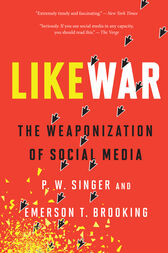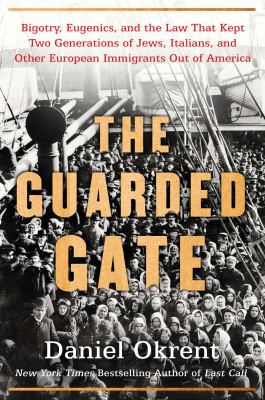 W. Singer and Emerson T. Brooking, LikeWar: The Weaponization of Social Media (2018, Mariner Books, Boston, 2019), 407 pages including index and notes plus eight pages of photos.
W. Singer and Emerson T. Brooking, LikeWar: The Weaponization of Social Media (2018, Mariner Books, Boston, 2019), 407 pages including index and notes plus eight pages of photos.
This timely book begins in 2009 with Donald Trump’s first tweet, promoting his appearance on David Letterman that evening. It then weaves various threads such as political operatives use of social media in the 2016 campaign, to celebrities who use Social Media to increase their fan base, and to social media’s reach onto the battlefield. Social media was used to ignite the “Arab Spring.” There were many who felt it held a promise to bring more democratic processes into autocratic countries. But the dictators who survived learned and soon, social media was being used by those on both sides, such as in Syria. Isis also learned to effectively use social media, not only to recruit followers but to terrorize the countries in which they operated. Isis captured the city of Mosul with much smaller army and one poorer equipped because the Iraqi forces were so scared of Isis’ inhumane acts toward their enemies which were splashed across social media. By the time Isis arrived in the backs of pickup trucks, the Iraqi garrison had fled. Today’s battlefield involves not just military tactics, but social media strategies. In some cases, enemy fighters taunt those on the other side on social media, making them feel more vulnerable. Not only is social media changing the way war is fought, it is changing the meaning of war.
Social media has quickly been adopted as a way for us to remain connected with friends and family, but it is also the place most Americans get their news. The authors spend significant time discussing the development of the internet and then the evolution of social media. As the various menus of media grows, so do those who attempt to use such media to sway our opinions. While Singer and Brooks extensively covers the Russia use of social media as a way for them to influence politics around the world, from the British Brexit vote to the American elections, they have also looked at how other countries have used social media for their own purposes. Truth and fact checking that used to be expected by the established news media is now out of the window. And because everything is based on algorithms that few understand, social media can be used to make the outlandish seems true (why else, would so many people like something is it wasn’t true).
Of course, it’s not all about “fake news.” Some countries want to limit the news their citizens receive. China, in a way to only let its people know what the party wants them to know have created a firewall to control unwanted information which has led to humorous stories. When a study published under the title of “the Panama Papers,” which documented how many in the upper echelon of the party were stashing money overseas, Chinese firewall quickly blocked anyone from seeing anything that mentioned Panama. For a while, an entire country ceased to exist, at least according to the Chinese internet, under the internet police changed their blockage from anything Panama to “Panama” and other key words.
At the end of the book, the authors argue that social media companies (most of whom are U. S. based companies, need to be more responsible for how their technology is used.
In a perfect world, I would recommend this book, or something similar, to be read by every voter. But then, a perfect world wouldn’t have such issues with social media!
###

Daniel Okrent, The Guarded Gate: Bigotry, Eugenics, and the Law that Kept Tw o Generations of Jews, Italians, and Other European Immigrants Out of America (New York: Scribner’s, 2019), 478 pages including an index, bibliography, notes, along with several pages of black and white photos.
This is a difficult book, to read and to realize people thought this way. However, the message is important and the book is well researched which is why I gave it 4 stars on Goodreads. The author begins in the 19th Century and looks at how native born Northern European Americans saw themselves as the ideal race. Using science (especially drawing on Darwin’s theories), they debated how they might protect the race and even improve the race. This had profound impact across the society including non-voluntary sterilization in most states. But Okrent, while acknowledging these other implications, focuses his study of this “false science” on its influence in the immigration debate in the late 19th and early 20th centuries. The thrust of the book essential ends with the 1924 legislation that limited immigration at a percentage of those who ancestors came from counties as defined in the 1890 census. After the passage of this act, which remained the law until 1965, the author only briefly notes how the American debate over race and eugenics was picked up by the Nazis in Germany.
Starting with leading American families from New England, there was a rising concern about what immigration was doing to America in the late 19th Century. Leading politicians like Boston’s Henry Cabot Lodge sough a restriction in immigration but ran up against obstacles. Literacy was one of the restrictions, but as schools began to be more popular in places like Italy, educational barriers were no longer effective at reducing the influx of new populations. Immigration kept the price of labor cheap, which meant that many business leaders wanted new immigrants. Steamship companies often brought empty ships to America in order to ship American products (especially timber) to Europe found immigration to a windfall to their business. Business leaders saw that the attempts to restrict immigration kept failing. In an attempt to boost their argument, many who were against the immigrants south to support their arguments with science. The proposed there was a danger of mixing American blood (Northern European) with the blood of those deemed less desirable. It’s interesting (and frightening) how groups like the American Breeder’s Association, which had worked to improve agricultural practices such as raising healthier sheep, growing higher yielding soybeans and corn, and mildew-resistant cherries, began to debate at how to build a better “human.” Thankfully, these ideas never took a strong hold in the United States, but these ideas did catch on in Germany and even after the war, it was used as a German defense at the Nuremburg Trials, where Hitler’s “doctors” pointed to America as the source of their heinous ideas on race (see pages 392-393).
While there were many conservative and traditional politicians and business leaders drawn to such theories as a way of avoiding “racial suicide,” such as Henry Cabot Lodge and Henry Adams, this was not only an issue supported by conservatives. Those with more progressive views such as Madison Grant (of the Bronx Zoo Fame), Teddy Roosevelt and Eleanor Roosevelt also supported such views. Okrent follows the money and intellectual trail, as he links the support of such research, the scientist involved (such as Charles Davenport and Fairfield Osborn), the leading universities, and those funding such studies (which included Rockefeller, the Harriman family, and the Carnegie Institute. Also thrown into the mix includes Margaret Sanger, founder of Planned Parenthood and Samuel Gompers of American Labor fame. In a way, the ideas that lead to the 1924 restrictive immigrant policies in America, drew support from leading thinkers across America. It is sobering to look back today and to see the flaws in their thinking. As Nazism began to rear its ugly head, most moved away from such theories.
Okrent notes how his own publisher (Scribner) supported such theories in the past. Madison Grant’s book, The Passing of the Great Race, and Lothrop Stoddard’s Rising Tide of Color against the White World, were both published by Scribner.
It would be nice to know such ideas that were popular in the United States in the early years of the 20th Century are no longer present as we move into the 21st Century, but I’m not so sure. The recent debate over immigration and with a book like Pat Buchanan’s The Death of the West: How Dying Populations and Immigrant Invasions Imperil Our Culture and Civilization (2002), makes me wonder if there are still those who hold on to such ideas about race.
While Okrent mentions issues with Asian immigration, and early anti-Catholic immigration issues, this book primarily focuses on the attempt to limit immigration from Southern and Eastern Europe. I listened to this book via Audible, and then checked out the book from the library and read selections in preparation for a book group meeting where we were discussing this book.
###

Excellent reviews of two very important books. Thanks for your recent comment on my blog, because I had otherwise somehow missed this post!
Social media topics are very popular now 🙂
Both of these pique my interest. One I loved from last year was Digital Minimalism, which might be a good companion to your first one. We had a stimulating discussion about racial reconciliation in church this morning, so the subject matter of the second one is fresh on my mind. Will put both on my TBR. Thanks.
Both look interesting, and most definitely relevant.
I also just read your Virginia City article. Thank you for sharing it. It’s interesting how much of the historical record relates to funerals, though I suppose that makes sense in light of the role of the church in the West.
educational and thought-provoking books — thanks for sharing your reviews and info about them. just like everything, there are pros and cons to social media, and immigration!
also wanted to say thanks for stopping by my Beast World campaign at Lee’s!
These books both sound like must reads. The first one would be eye-opening even though we know the impact social media has had on the last U.S. election. I’m sure there’s much we don’t know as we twee away our days. The second book is frighteningly relevant to our current times. Excellent reviews, Jeff. Thanks for sharing these.
The first one sounds so interesting to me!
It’s fascinating, and fascinatingly scary, what a power tool we have in the social media. It makes or breaks micro relationships as well as global.
Have a please weekend and Shabbat Shalom, Sage.
Whether we like it or not social media is here!
It can be good but it can be bad!
Many thanks for these reviews.
Happy March Wishes.
All the best Jan
I would like to read first book…interesting for me, because it is a kind of “effective propaganda” for politicians in many countries.
Have a wonderful day
Pretty intense, Jeff. I compare the rapid growth in social media to the speed with which our climate is changing. If we had a few thousand years, we’d adapt, but we don’t have that luxury anymore. My first encounter with the concept of media and all its implication came with Marshall McCluhan. I still remember puzzling over his ideas about what media is and how it affects us. Now I’m steeped in the very thing he was writing about.
As to the Guarded Gate, I shake my head. I doubt very much the human race will have time to evolve out of the “them” and “us”. We’ve had a few million years and we just can’t part with the idea that some of us are better than others–usually based on how we look or sound.
Great and thorough reviews!
Who would have thought that such a thing as Social Media would even exist when we were kids. Now, it is a powerful force in our lives that can be used for both good and bad reasons. We need to exercise caution and be aware of how it can be used to manipulate and influence us. Thanks for your reviews on these two books.
Yeah, not even when we were kids—even in the 90s, this seemed far fetched. Wonder what’s next?
I remember skimming through Pat Buchanan’s book in a book store years ago and laughed out loud at his Nazi-lite words. Even worse, in another book Buchanan blamed WW2 on Churchill with him soft pedaling Hitler into not such a bad guy.
Doesn’t Pat still have a column on some website?
I am sure he has a column somewhere on the internet, but thankfully it’s not on my radar! I never read his review, only a review of the book, and I wasn’t impressed. With this book, I began to see how he was recycling old ideas.
Social media can be both a blessing and a curse. On one hand, it brings people closer together and helps people become friends who may have otherwise never met. On the other hand, it can be a tool that manipulates and causes pain.
Social media is a tool–and as it is with all technology and tools, it can be used for good or bad. Remember “Maxwell’s Silver Hammer?” A hammer can build houses and crack heads :).
Thank you for your comprehensive reviews of these two books, Jeff. Both sound like they are thought provoking, powerful reads. I agree that we need to understand what’s going on. Sometimes I think there is no hope for our world and that we just can’t seem to learn from the past. But I’m not someone who can live without hope. I pray daily for hope, peace, understanding, and healing in this world. I know, a praying agnostic sounds like a disconnect. But I do have hope!
A “praying agnostic” brought a smile to my face, Louise. Keep praying and hoping!
The book on social media would make me cringe. It has become weaponized in many ways.
Yes, but we need to understand what’s going on so at least we know what’s happening. It’s not a cringing book (except for some of the Isis propaganda stuff)
Social Media is so crazy now a days. It’s not just for keeping in touch with family anymore.
Yep, it’s all about making a buck off us! Or making us think their way!
Both books look interesting, but I think I’m drawn more to the first. It might be a good follow-up to one I read in January: So You’ve Been Publicly Shamed by Jon Ronson.
Ronson’s book sounds interesting, but there is only so much time!